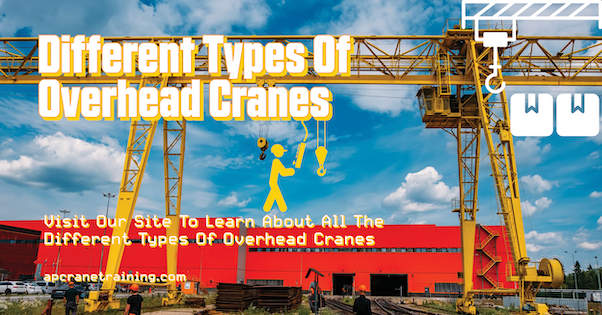
Main Takeaways:
- Overhead cranes are essential for industrial material handling.
- Types include bridge, gantry, jib, monorail, and more.
- Each crane serves a specific function and environment.
- OSHA regulations require certified training and safe operation.
- AP Crane Training offers comprehensive, compliant crane certification programs.
Overhead cranes are the backbone of heavy material handling across countless industries. From shipyards to manufacturing plants, these machines are responsible for lifting, transporting, and positioning large loads with precision and efficiency. However, not all overhead cranes are built the same. Each type serves a specific purpose based on factors such as load capacity, environmental conditions, and the nature of the task at hand. Understanding the different types of overhead cranes and their ideal applications is crucial not only for operational efficiency but also for workplace safety and regulatory compliance.
At AP Crane Training, we specialize in preparing operators and companies to safely and effectively utilize overhead cranes through professional instruction and OSHA-compliant certification.
What Is an Overhead Crane?
An overhead crane is a type of equipment used to move heavy materials horizontally within a facility. These cranes generally consist of parallel runways with a traveling bridge that spans the gap. A hoist travels along the bridge.
Key components include:
- Bridge: The main horizontal beam that spans the workspace.
- Runway: The tracks the bridge travels on.
- Hoist: The lifting device that moves along the bridge.
- Trolley: Carries the hoist across the bridge.
1. Bridge Cranes
Single Girder vs. Double Girder:
- Single Girder: One beam, lighter loads, cost-effective.
- Double Girder: Two beams, heavier loads, greater hook height.
Applications: Manufacturing, warehouses, assembly lines.
Environments: Indoor with structured ceilings.
OSHA: Compliance with 29 CFR 1910.179.
2. Gantry Cranes
- Full Gantry: Legs on floor rails.
- Semi-Gantry: One leg on rails, one side wall-supported.
- Portable: Movable with casters.
- Adjustable: Variable height and span.
- Rail Mounted: Fixed rails for heavy-duty tasks.
Applications: Shipbuilding, railyards, outdoor storage.
Environments: Indoor/outdoor.
Training: Includes weather and terrain safety.
3. Monorail Cranes
Applications: Assembly lines, production.
Environments: Linear path factories.
Advantages: Simple and cost-effective.
OSHA: Operator path and maintenance training required.
4. Jib Cranes
- Wall-Mounted: Limited motion.
- Freestanding: More mobility and capacity.
- Articulating: Multiple arms for reach.
Applications: Workstations, docks.
Environments: Indoor/sheltered.
Training: Emphasizes swing radius and load control.
5. Workstation Cranes
Applications: Labs, small factories, healthcare.
Environments: Clean, controlled.
Advantages: Ergonomic and mobile.
Training: Focus on strain prevention and safe handling.
6. Process Cranes
Applications: Steel mills, power plants.
Environments: Harsh, high-temp.
Training: High-stakes operations and heavy load handling.
7. Top Running vs. Under Running Cranes
- Top Running: Heavier loads, needs more headroom.
- Under Running: For tight spaces, hangs below runway.
Applications: Load and space dependent.
Training: Visibility, clearance, and control training.
8. Automated Overhead Cranes
Applications: Manufacturing, warehousing.
Environments: Modern logistics.
Benefits: Precision, reduced error.
Training: Manual override, software/hardware safety checks.
9. Modular Cranes
Applications: Flexible production, temporary setups.
Environments: Workshops, scalable cells.
Benefits: Easy configuration and scalability.
Choosing the Right Crane
- Load Capacity
- Frequency of Use
- Facility Layout
- Required Mobility
- Environmental Conditions
Partner with AP Crane Training to ensure correct crane selection, operator certification, and OSHA compliance.
OSHA Training and Certification
Regulation: 29 CFR 1910.179
- Frequent/periodic inspections
- Load testing post-installation
- Certified trainers
- Emergency and daily safety procedures
Certified Operators Must:
- Understand load charts
- Conduct pre-operation checks
- Identify operational hazards
A Crane for Every Job
Each type of overhead crane, from bridge to modular, has specific strengths and operational roles. Choosing the right system and training operators properly ensures both efficiency and safety.
Learn With AP Crane Training Today!
AP Crane Training is your partner in operator education and compliance. Call us at (888) 501-1355 or email info@apcranetraining.com to learn more about our OSHA-certified training programs.
